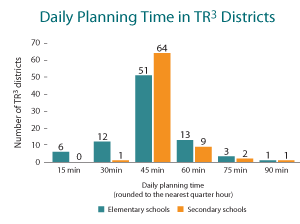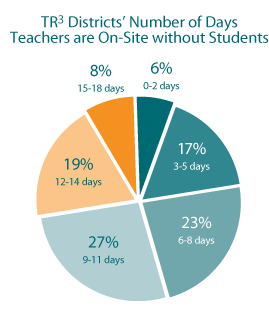Welcome to Tr3 Trends, NCTQ's new monthly newsletter for school districts (subscribe here). Each month we'll use data from NCTQ's Tr3 database to highlight the latest trends in school district policies and collective bargaining agreements nationwide. Tr3 contains teacher policies from 113 school districts, including the largest 50 districts, Broad Prize winners, Gates investment districts, and members of the Council of the Great City Schools. It's available online at http://www.nctq.org/tr3.
This month we dug into our database to see how much planning time teachers get to prepare lessons, collaborate with colleagues, and engage in professional development. Here's what we found.
Elementary school teachers in Tr3 districts are more likely than secondary teachers to get daily planning periods of 30 minutes or less.

Eighteen districts in the Tr3 database give elementary school teachers daily planning time of 30 minutes or less, while only one district does so for secondary teachers.
San Francisco and San Diego give elementary teachers the least planning time each day, with 12 minutes, on average. Leading the pack with the most planning time are Montgomery County and Anne Arundel County in Maryland, which give about 80 minutes to elementary teachers, and Fresno, California which gives secondary teachers a whopping 96 minutes per day.
26% of Tr3 districts give teachers additional planning time to collaborate.
Kansas City, Missouri gives the most collaborative planning time: 40 minutes of "common time", four days a week. Runner-up is the District of Columbia, which lets teachers use daily 30-minute "morning blocks" for collaboration, followed by Denver, which says teachers can use up to 120 minutes a week for department and grade-level meetings, faculty meetings, and vertical teaming.
In 48% of Tr3 districts, teachers work an average of 10 or more days on-site without students.

Who has the most teacher workdays without students? Wake County, North Carolina has 18 days and Wichita has 17. Granite School District in Utah has an average of around 17 day ? that's 25.5 for elementary teachers but only 9 for secondary.
Districts with only two days where teachers work on-site without students are: Fresno; Long Beach; Los Angeles; Hawaii; Buffalo; and Spokane, Washington. Providence, Rhode Island doesn't require its teachers to work any days on-site without students.
The average number of teacher workdays without students in TR3 districts is 8.75 days.
Go to Tr3's custom report page to access all the data we use in Tr3 Trends and to compare teacher policies in 113 school districts nationwide. Send feedback to gmoored@nctq.org.
